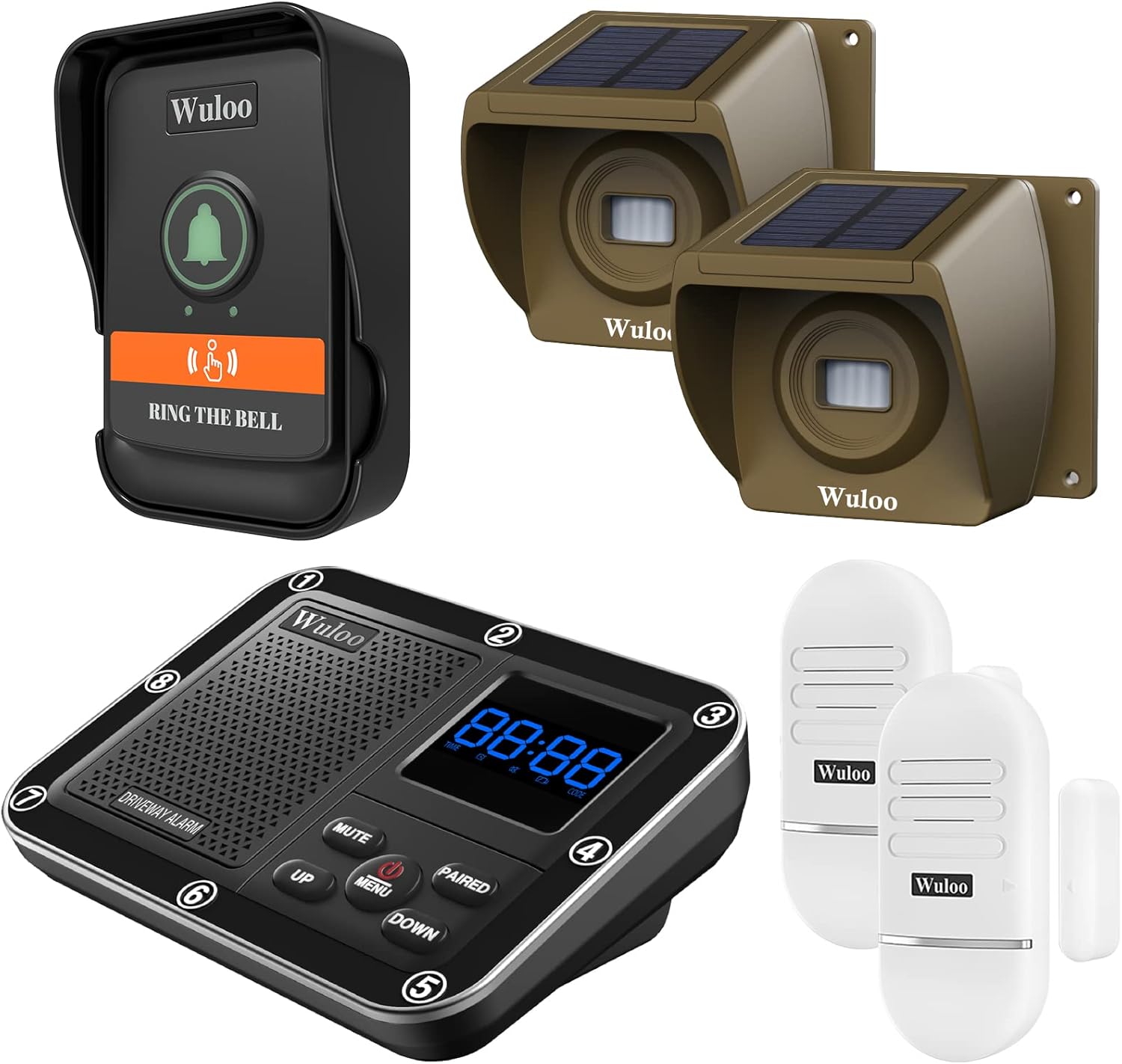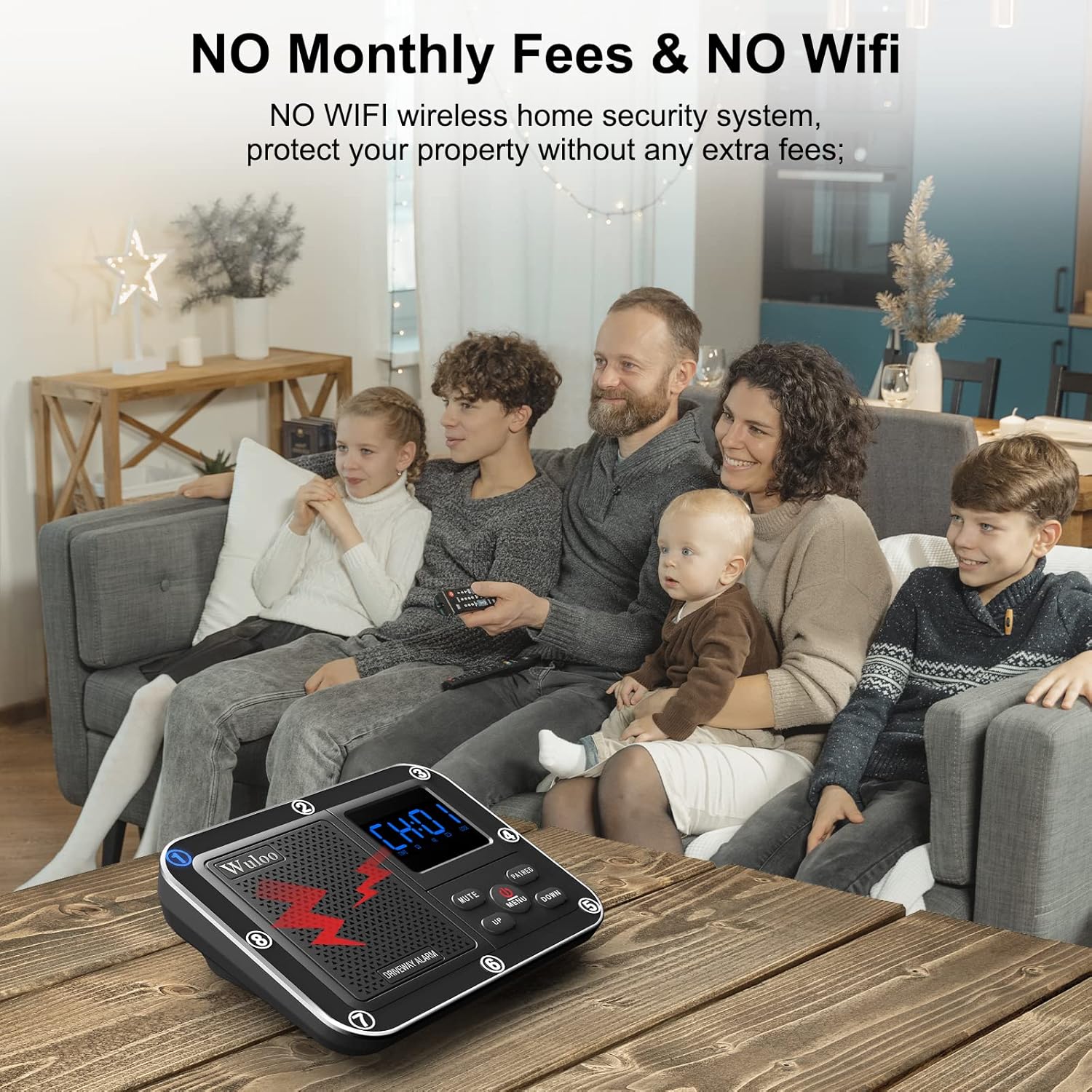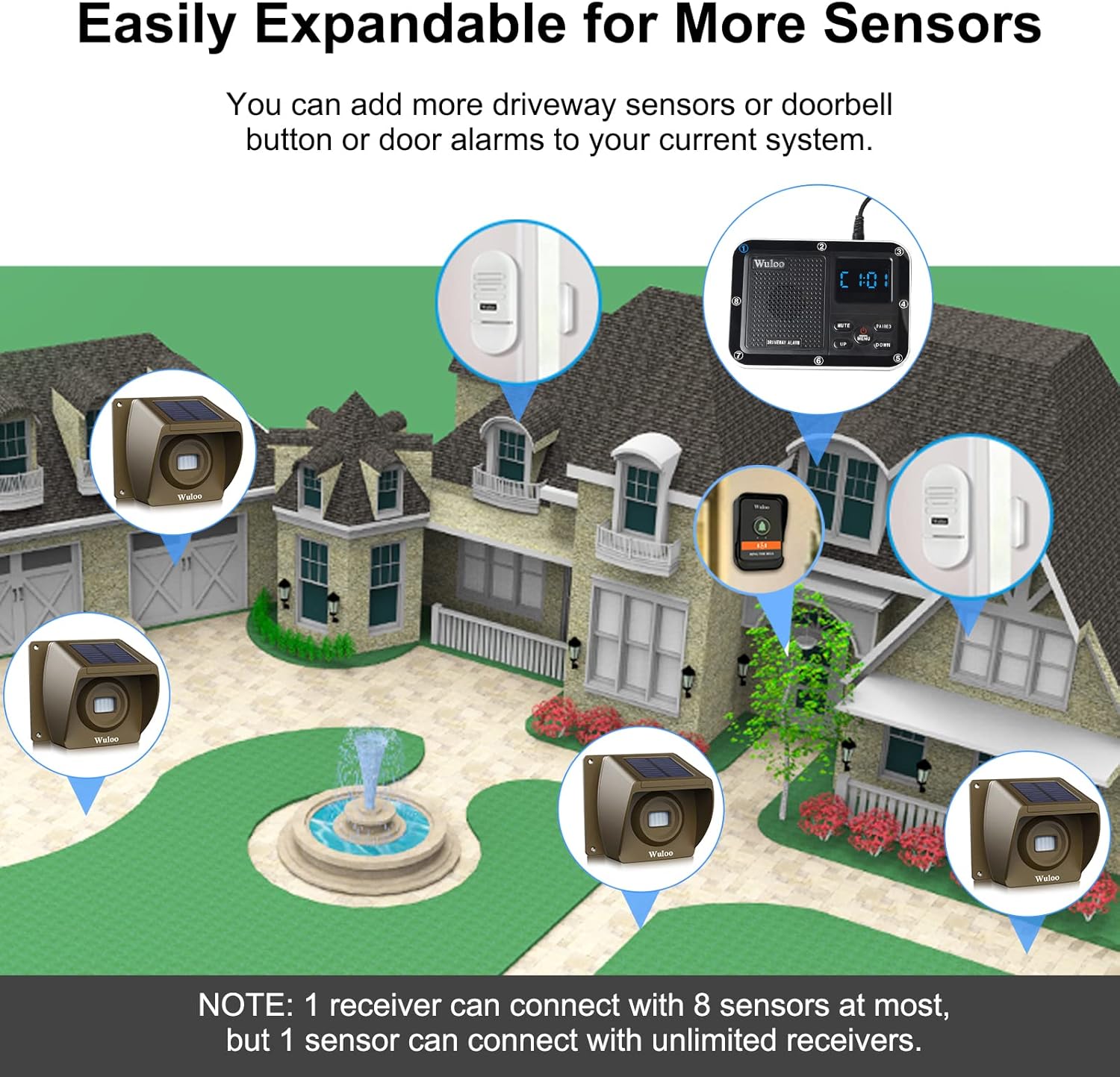What would it feel like to protect your home with a system that asks for so little of your time and attention yet gives you so much of a quiet, steady reassurance?
This image is property of Amazon.com.
Quick impression of Wireless Alarm System for Home Security Expandable – 6-Piece Kit Include Doorbell, Door Alarm, and Solar Driveway Alarm – Chime/Sensitivity Adjustable NO Wi-Fi NO Monthly Fee With Rechargeable Battery
You’ll find this kit unusually plainspoken in its promise: protection without the internet, without monthly payments, and without an installer needed. It arrives as gear you can charge, click on, and set where you need it, which makes it appealing if you want security to fit into family life rather than require you to rearrange it.
Wireless Alarm System for Home Security Expandable - 6-Piece Kit Include Doorbell, Door Alarm, and Solar Driveway Alarm - Chime/Sensitivity Adjustable NO Wi-Fi NO Monthly Fee With Rechargeable Battery
What’s in the box
You get a 6-piece kit that already sounds like a small household: a main door alarm unit, a doorbell sensor, a solar driveway sensor, and a selection of contact sensors. Everything is intended to work together right out of the box. The manufacturer includes a quick-start guide, a detailed manual, and an instruction video so that most of the heavy thinking has been done before it reaches you.
Included components and basic roles
Each component has a straightforward role: the door alarm acts as the central chime and control hub, the doorbell sensor notifies when someone’s at the door, and the solar driveway sensor watches a stretch of your driveway or yard for passing human activity. You can add more sensors later, so the kit behaves like the beginning of a system rather than the end of one.
What to expect from packaging and documentation
The paperwork and quick-start guide aim to reduce friction—you charge, power on, test, and install. If you like things that arrive organized and almost apologetically simple, you’ll appreciate the documentation. For those who want to skip reading, there’s a testing process that confirms everything is paired before you mount it.
Key features at a glance
You’ll notice a few highlighted selling points immediately: no Wi‑Fi required, no monthly fees, adjustable sensitivity, multiple chimes, rechargeable batteries for each sensor, and a solar-powered driveway sensor boasting long life. These features are meant to keep the system independent and low-maintenance.
No Wi‑Fi & no monthly fees
If you prefer security that doesn’t tether itself to your home network, you’ll value that this system communicates via wireless radio protocols (FM/ASK/FSK) developed by the manufacturer. That means you won’t rely on cloud services, and you won’t be billed monthly. For privacy-conscious households or renters with network restrictions, this is a practical advantage.
Sensitivity and chime customization
You can adjust sensitivity for individual sensors and assign different chimes to help you identify which sensor is triggering without running to check. This gives you control: set a low sensitivity on a driveway sensor to ignore wildlife, and a higher sensitivity on a front-door contact that should catch every opening.
Rechargeable batteries & solar driveway sensor
All sensors use rechargeable batteries, which simplifies maintenance and reduces waste compared with throwaway batteries. The solar driveway sensor is marketed to keep working for about 24 months after a full charge—an attractive claim if you don’t want to think about battery swaps regularly. Practically, how long that lasts will depend on your climate and how often it’s triggered.
Expandability and installation options
You can add more sensors, and the door alarm can be mounted with 3M tape or screws. If you prefer a cleaner look without holes, the tape option gives you a low-impact installation. If you want permanence, screws are there. Expandability makes the kit a starter set that you can grow.
Technical summary table
Below is a table to help you compare the main specs quickly. It’s organized so you can glance at what matters and decide if this aligns with your needs.
| Feature | Details |
|---|---|
| System Type | Wireless, FM/ASK/FSK technology |
| Wi‑Fi Required | No |
| Monthly Fee | None |
| Kit Includes | 6 pieces: door alarm unit (chime), doorbell sensor, driveway solar sensor, additional contact sensors |
| Power | Rechargeable batteries for sensors; solar for driveway sensor |
| Solar Driveway Sensor Life | Claimed ~24 months after full charge (usage-dependent) |
| Chimes | Multiple selectable chime sounds; assignable per sensor |
| Sensitivity | Adjustable per sensor to reduce false alarms |
| Installation | 3M tape or screws for door alarm; adhesive or mounting for sensors |
| Expandability | More sensors can be added |
| Temperature Range | Wider temperature range specified (manufacturer claim) |
| Manufacturer | Wuloo (over 10 years experience; specializes in wireless tech) |
| Included Documentation | Quick-start guide, detailed manual, instruction video |
This image is property of Amazon.com.
Setup and installation
Setting up this kit is designed to be approachable even if you don’t enjoy tools. The manufacturer pre-configures most settings before shipment, so your steps are mostly charge, switch on, test, and mount. That sequence is intentional: it gets the system working before you fix things into place.
Charging and powering everything
You’ll charge each sensor before installation. The solar driveway piece has its own charging method thanks to the embedded solar panel, but all devices contain rechargeable batteries so you avoid repeated battery purchases. Let them charge fully, then press the power buttons and run the included pairing tests.
Mounting methods and placement tips
Use 3M tape if you live in rental housing or prefer a less permanent installation; use screws for a more stable fix. For sensors on doors, keep the magnetic contacts aligned to avoid misreads. For the solar driveway sensor, place it where it can see the area you want to monitor and also receive enough sunlight to recharge.
Performance and reliability
The system’s radio-based communication aims to reduce reliance on internet infrastructure and lower vulnerability to cloud outages. Reliability in practice will depend on distances between sensors and the chime unit, possible interference from other radio devices, and environmental conditions.
Range and signal considerations
You’ll want to test signal range in the exact spots you plan to install sensors. The manufacturer’s testing in customer-like environments suggests reasonable range, but thick walls, metal enclosures, and other radio sources can affect performance. Pair, then walk the path you expect the sensors to track to confirm triggers.
False alarms and sensitivity tuning
Because the sensitivity is adjustable, you can reduce nuisance alerts by lowering sensitivity on areas prone to motion (like a driveway with cars passing) and raising it on doors where you need immediate notification. The goal is to balance catching real events while ignoring benign movement.
This image is property of Amazon.com.
Use cases: how it fits into daily life
Think of this system as an unobtrusive addition to your home rhythm. It’s not meant to replace professional monitoring for high-risk situations, but it fits several practical scenarios: renters who can’t drill holes, families who want simple alerts when kids come home, gardeners watching a drive for deliveries, or older adults who need a straightforward chime system.
For renters and homeowners who avoid complex installations
If you move regularly or live under a tenancy agreement that forbids hard wiring, you’ll like the adhesive options and the fact this system doesn’t demand a professional visit. It’s designed to be something you can take with you or remove without causing damage.
For families with varying schedules
You can assign different chimes to front door, back door, and driveway sensors so you and other family members know where activity is happening. That helps maintain a calm household rhythm—no one needs to race each time the chime sounds because you’ll typically know which sensor it is.
For privacy-focused users
Because there’s no cloud account or Wi‑Fi gateway, the system is attractive for people who prefer local-only solutions. You get alerts inside your home without sharing data with third-party servers.
Customer service and support
Wuloo emphasizes professional customer service and says their factory finishes initial settings before shipping. The kit comes with manuals and a detailed video. If you prefer real human help, their stated approach aims to be responsive, and their technology background suggests they’ve iterated based on feedback.
What to expect when you need help
You’ll likely find troubleshooting guidance in the manual and video. For persistent issues, you can contact support; the company’s emphasis on testing in real customer environments implies practical service knowledge for common problems.
This image is property of Amazon.com.
Durability and environmental considerations
The system claims a wider temperature range and a long-lasting solar sensor battery. If you live in climates with hot summers or freezing winters, pay attention to where sensors are placed; extreme temperatures still influence battery life and component longevity.
Outdoor use and weather resistance
The driveway sensor includes solar charging, suggesting some level of outdoor readiness, but you should mount it with some protection if your area experiences frequent storms or persistent humidity. Check seals and mounting points regularly.
Long-term upkeep
Rechargeable batteries and solar charging reduce waste compared with single-use batteries. Still, you’ll need to schedule occasional charging maintenance, especially for devices that trigger often. Periodic tests help ensure reliability.
Pros and cons
Putting the features and trade-offs in one place helps you weigh what matters.
Pros
- No Wi‑Fi and no monthly fees—simple, privacy-friendly operation.
- Rechargeable batteries for each sensor; solar option reduces maintenance for the driveway sensor.
- Adjustable sensitivity and assignable chimes make alerts meaningful rather than intrusive.
- Expandable: you can add more sensors as your needs grow.
- Easy to install with 3M tape or screws.
Cons
- Radio-based systems have practical range limits; signal can be affected by household interference.
- The solar sensor’s claimed 24 months of operation will vary with sunlight and actual usage, so it may not always match the ideal.
- No remote notification outside the house, because the system does not connect to the internet—if you want alerts while you’re away, this system won’t provide them.
- If you expect professional monitoring or mobile push notifications, you’ll need additional services or a different product.
This image is property of Amazon.com.
Comparison with Wi‑Fi and cloud-based systems
You’ll trade remote monitoring capability for local reliability and privacy. Cloud systems can send you push notifications, integrate with smart home platforms, and offer professional monitoring. This Wuloo product instead focuses on independence: no subscriptions, no accounts, and fewer digital footprints.
When this system is the better choice
Choose this system if you want simple, immediate alerts inside your home, prefer not to have security hardware connected to the internet, or live in a place where Wi‑Fi is unreliable. It’s also better if you’re sensitive to subscription costs and prefer a system you can expand gradually.
When a cloud system might suit you better
If you need remote alerts on your phone, video recording, or integration with smart home devices like voice assistants, a cloud-based system will be more suitable. Those systems, however, come with recurring costs and more complex privacy considerations.
Real-world testing advice
Before you commit to permanent mounts, power up and pair everything where you plan to place it. Walk paths where motion should be detected, open doors to confirm contact sensors trigger, and try different sensitivity levels. This testing routine saves you from surprises later.
Steps for a thorough test
- Charge each sensor fully.
- Power on the chime unit and each sensor, then perform the pairing tests.
- Walk in front of the driveway sensor at typical speeds—if you drive by slowly or a child rides a bike, check whether the trigger settings are correct.
- Open and close doors to verify contact sensors report reliably.
- Change chime assignments to make sure you can distinguish alerts by sound.
This image is property of Amazon.com.
Installation tips and tricks
Small placement decisions will matter as much as the kit itself. Mount the driveway sensor on a post at the right height for detecting human movement rather than small animals. For door contacts, align the magnets precisely—misalignment invites false positives.
Where to avoid placing sensors
Don’t place sensors behind metal screens or in direct line of known sources of interference like large speakers, certain wireless devices, or dense utility boxes. Avoid locations that experience temperature extremes without shelter, as batteries perform worse in severe cold or heat.
Making chime choices that reduce stress
Pick a pleasant, distinct chime for each sensor; avoid blaring tones that cause anxiety. If a chime becomes too frequent, lower sensitivity rather than muting it—muting can make you miss important events.
Maintenance and battery care
You’ll need to charge periodically and check solar panels for dirt and shade. A small maintenance routine every few months will keep the system responsive and reliable.
Recharge schedule and solar upkeep
For indoor sensors, charge when battery indicators fall to suggested levels. For the solar driveway sensor, wipe the panel occasionally to remove dust or fallen leaves. In darker months, consider supplementary charging so you don’t lose coverage.
Firmware and settings
Because this product doesn’t use Wi‑Fi, firmware updates aren’t automatic. The manufacturer’s pre-configuration helps, but you should consult support if you learn of system updates or recommended setting changes.
This image is property of Amazon.com.
Troubleshooting common issues
If a sensor won’t register, check alignment and battery level first. If chimes are inconsistent, verify line-of-sight and test for interference. The manual and video are practical first stops before contacting support.
Noise and false triggers
If the driveway sensor picks up passing cars or animals, lower its sensitivity or adjust its placement angle. If the door contact triggers without movement, realign the magnets and ensure the mounting surface is even.
Signal loss or range problems
Try moving the chime unit closer to problematic sensors as a temporary fix. If that resolves the issue, consider relocating the chime unit permanently or adding additional chime units if the system supports them.
Privacy and security considerations
You’ll appreciate that having no cloud connection reduces exposure of your alerts to third parties. On the flip side, you won’t receive alerts when you’re away from home. Decide which factor matters more for your household.
Physical security versus remote monitoring
This product enhances immediate, in-home awareness and physical deterrence. If you need evidence after an incident or remote alerts to your phone, combine it with another device (like a camera system) that offers cloud features, understanding that will introduce subscription and privacy trade-offs.
This image is property of Amazon.com.
Frequently asked questions (FAQ)
You’ll likely have questions about range, battery life, expandability, and whether the system requires professional installation. Below are concise answers to common concerns.
How far can the sensors be from the chime?
Range depends on walls, interference, and placement. Test intended locations during setup to ensure reliable signaling; thick masonry or metal can reduce effective distance.
Can you add more sensors later?
Yes. The system is expandable so you can add additional contact sensors, motion sensors, or other supported devices to cover more points.
Does it send notifications to your phone?
No. The system does not use Wi‑Fi or cloud services, so it won’t send remote push notifications. You’ll receive alerts through the chime unit inside your home.
How long do sensors run on a charge?
All sensors are rechargeable; the solar driveway sensor claims about 24 months of operation after a full charge under ideal conditions. Real-world battery life will vary with frequency of triggers and environmental factors.
Final thoughts and verdict
If you want a low-friction, low-cost, privacy-minded way to add audible protection to your home, this Wireless Alarm System for Home Security Expandable – 6-Piece Kit Include Doorbell, Door Alarm, and Solar Driveway Alarm – Chime/Sensitivity Adjustable NO WI‑FI NO Monthly Fee With Rechargeable Battery presents a thoughtful option. It’s tuned to blend into household routines: simple to set up, quiet in its demands, and alive with small but meaningful features like chime customization and adjustable sensitivity.
You’ll find it especially suitable if you’re a renter, someone who cares about limiting online exposure, or a household that values in-home alerts over remote monitoring. It’s not for you if remote notifications and cloud-based integrations are essential. Yet for many families, the balance it offers—practical, adaptable, and respectful of privacy—will fit naturally into daily life, in the way good household gear often does: quietly present, steadily useful, and unobtrusive until you need it.
Disclosure: As an Amazon Associate, I earn from qualifying purchases.












